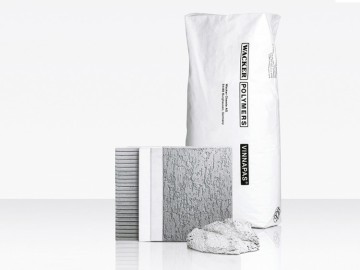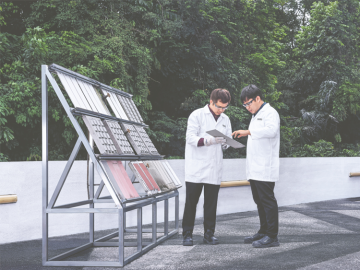Our system has noticed that you are based in United States, but the current country setting is Chile. Do you still want to change your country?

If Walls Could Speak
Walls define rooms, create boundaries and offer protection. Sometimes we find ourselves wondering what goes on behind them. But do we know what goes into them? We usually don’t give this a second thought. And yet, what walls are made of is important for our safety, our well-being and even for climate protection.
There’s More to Walls than Meets the Eye!
Walls are a multi-layered affair. Starting from the internal face and working outward, we have the top layer, which is usually paint, wallpaper, wood paneling or tile. Underneath, there is plaster, primer, possibly gypsum board, insulation and finally the core of brick, concrete or wood. Weatherproofing begins on the other side. It can include external insulation, almost always a primer, exterior plaster, or some kind of exterior cladding, and a coating.

Feel-Good Climate Comes in Many Shades: Interior Paints
The desire for color is as old as mankind itself. Clothing, jewelry, objects, walls have always been embellished with available colors. The color palette has grown over the millennia. From earth tones to red tones and finally to blue tones. We expect a lot from interior wall paints these days: they should have a particular shade, be washable if possible and, of course, not contain any harmful substances.

Good adhesion to the substrate, high hiding power, dirt pick-up resistance, and low VOC content. Interior paints formulated with VINNAPAS® dispersions meet sophisticated requirements.
Indispensable – the Binder
Aside from the pigment that provides the color, the main ingredient in an interior wall paint is the binder. This is frequently a polymer dispersion. WACKER has been producing and developing dispersions based on vinyl acetate – our VINNAPAS® range – since 1938. It was the advent of copolymer dispersions in the 1960s, especially those based on vinyl acetate-ethylene (VAE), that made it possible today to produce virtually odorless wall paints and combine a low VOC content with excellent practical properties.

Powder paints are lighter than liquid paints and less bulky. This not only makes them practical, but also improves their carbon footprint during transportation and storage.
On Trend: Next-Generation Powder Paints
NEXIVA® powder-form binders for wall paints are an interesting Innovation. They make it possible to produce modern high-performance powder paints that are redispersed in water just before use and work without preservatives, such as biocides.
Find out more
Climate Protection Is All Over the Walls: Thermal Insulation
Energy consumption by buildings continues to rise worldwide. If the Paris climate goals are to be achieved, though, the building sector must be absolutely carbon neutral by 2050. Energy efficiency and, by extension, thermal insulation is the key lever here. Because insulated walls slash energy consumption without affecting comfort levels. Quite the opposite is true: the indoor climate also benefits when fluctuating outside temperatures can no longer penetrate living spaces unhindered.

External thermal insulation composite system in which mineral wool serves as insulating material
A Modern Classic: External Thermal Insulation Composite Systems
1957 saw the first house to be fitted out with an external thermal insulation composite system in Germany. In the 1960s, the main focus was on lining concrete storage silos for sugar or flour with polystyrene panels (EPS) to prevent condensation on the interior walls. When the oil crisis hit in the early 1970s, the systems were then deployed in residential and office blocks as well. Nowadays, external thermal insulation composite systems come in all shapes and forms. EPS is not the only material used – mineral wool, flax, and hemp also serve as insulation. For optimum adhesion to the substrate and to boost the flexibility of the system, VINNAPAS® polymer binders are incorporated into the adhesive mortar and base coats.
Find out more
Thermal insulation render can also be applied by machine.
Thermal Insulation Render: the Slimline Variant
External thermal insulation composite systems lower the thermal conductivity of a wall by as much as a factor of 18. In more temperate zones, where it is neither very hot nor very cold, a thermal insulation render often also serves as an alternative. The system is much thinner and lowers the thermal conductivity by up to a factor of 9. Again, VINNAPAS® polymer binders play a key role here.
Find out more
Tradition 4.0: Renders
There is a long tradition of using renders on interior rooms and exterior walls. Whether renders should be used, and which types, is a matter of taste that changes with the times. Many regions use insulated bricks, which increase the chances of cracks developing on the surface of the facade. So a render that offers enhanced flexibility is crucial. WACKER offers binders and additives for all kinds of render types that will enhance important properties such as adhesion, flexibility, mechanical resistance, hydrophobicity and resistance to weathering.

A skim coat is 0.25 mm thick. The render consists of very fine fillers. VINNAPAS® polymer binders improve cohesion and adhesion.
Skim Coats: Nice and Smooth
While mainly coarse, textured renders are quite traditional in Europe, very smooth surfaces have always been preferred in Asia. This preference is increasingly spreading throughout India and Latin America. Skim coats produce seamless, flat surfaces that can be further embellished with paint. The very fine, polymer-modified special render is applied in ultrathin layers.
Find out more
Facade Paints: First Impressions Count
Architects love playing around with facade designs. But this can quickly become a headache for property developers. Renovation work is expensive and recurs with monotonous regularity. So, aside from the aesthetics, the most important criterion governing the formulation of facade paints is durability. It is not always possible to marry the two. Bright reds, for example, chalk easily, which is why long-lasting paints are often only available in a limited range of colors.

PRIMIS® dispersions extend the color space on facades.
New Colors Needed
UV light, rain, temperature fluctuations, and environmental pollution: exterior paints have to contend with a lot. Which is why they were usually colored with inorganic pigments in the past. Unfortunately, these cannot yield vibrant reds, oranges or blues. Our WACKER dispersions ensure that even organic pigments will retain their brilliance for a long time.
Find out more
Water droplets run off a silicone-resin network while water vapor is able to escape.
Networking with the Best
Silicone resin emulsion paints are bound with silicone resin. This offers two key advantages. First: Silicone resin forms an extremely durable three-dimensional network on mineral-based substrates. Second: This network is both hydrophobic and water-vapor permeable. Exterior paints based on SILRES® silicone resins keep facades looking their best for up to 30 years.
Find out more













